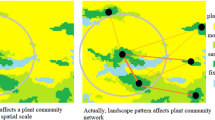Abstract
Two methods were employed to find spatial regularity in a complicated mountain landscape of Beijing, China on the basis of functional and structural affinities. The first approach applied Affinity Analysis based on species composition to landscape. The mosaic diversity of the landscape was 3.5298>3, which means the study landscape is complex and controlled by multiple environmental gradients. These landscape types were divided into 3 parts according to the mean affinity values of 0.2143 and 0.7857 (0.5±1 SD). Modal sites are the central types of the landscape, which include a zonal broad-leaved forest of the region and a conifer plantation replacing the former. Outliers are found in the highest altitude and the lowest, both have few species in common with the above two modal types. The remaining landscape types are intermediate sites, which are transitional between modals and outliers, broadly distributed throughout mountain environments. Neighbor types have more species in common than those more widely separated, which probably distributed adjacently in space or in similar quality habitat. The other method employed is the new TWINSPAN analysis by substituting spatial neighboring data of landscape types for species composition data. It clearly divided the landscape types into three groups, i.e., subalpine, middle and low mountain groups, which were correlated with altitude, as well as influenced by human disturbance. The new TWINSPAN classification method is more reliable in finding spatial gradient of patchy landscapes than affinity analysis; however, affinity analysis is useful in finding species diversity pattern and the importance of landscape types in a region. Integrating advantages of the two methods could supply complete and reliable information on how landscape types are distributed in space, which environmental gradient dominates the spatial distribution of the landscape types, as well as where important and unusual types are located.
Similar content being viewed by others
References
Caley, M. J. and Schluter, D. 1997. The relationship between local and regional diversity. Ecology 78(1): 70–80.
Chen, L. Z. 1997. The importance of Donglingshan mountain region in warm temperate zone deciduous broad-leafed forests. Pp. 1–9. In: Chen, L.Z. (ed.), Study on the structure and function of forest ecosystem in warm temperate zone. Chinese Science Press, Beijing, China (in Chinese).
Forman, R. T. T. 1995. Land mosaics. Cambridge University Press, London, UK.
Forman, R. T. T. and Godron M. 1986. Landscape ecology. New York, John Wiley, USA.
Guach, Jr. H. G. 1982. Multivariate analysis in community ecology. Cambridge University Press, London, UK.
Haines-Young, R. 1999. Landscape pattern: Context and process. Pp. 33–37. In: Wiens, J. and Moss, M.R. (eds), Issues in landscape ecology. International Association for Landscape Ecology, Fifth World Congress, Snowmass Village, Colorado, USA.
Hill, M. O. 1979. TWINSPAN-A FORTRAN program for arranging multivariate data in an ordered two-way table by classification of the individual and attributes. Cornell University, Ithaca, New York, USA.
Huo, Y. Z. 1989. Physical geography of Beijing. Beijing Normal University Press, Beijing, China (in Chinese).
Knox, R. G. and Peet, R. K. 1989. Bootstrapped ordination: a method for estimating sampling effects in indirect gradient analysis. Vegetatio 80: 153–165.
Krummel, J. R., Gardner, R. H., Sugihara, G., O'Neill, R. V. and Coleman, P. R. 1987. Landscape patterns in a disturbed environment. Oikos 48: 321–324.
Lengendre, P. and Fortin, M. J. 1989. Spatial pattern and ecological analysis. Vegetatio 80: 107–138.
Levin, S. A. 1992. The problem of pattern and scale in ecology. Ecology 73(6): 1943-1967.
Lobo, A., Moloney, K., Chic, O. and Chiariello, N. 1998. Analysis of fine-scale spatial pattern of a grassland from remotely-sensed imagery and field collected data. Landsc. Ecol. 13: 111–131.
Ma, K. M., Fu, B. J. and Zhou, H. F. 1999. Species and landscape pattern diversities of Donglingshan montane forest, Beijing, China. Acta Ecol. Sinica 19(1): 1–7 (in Chinese).
Ma, K. P., Chen, L. Z., Yu, S. L., Huang, J. H., Gao, X. M. and Liu, C. R. 1997. Basic plant community types in Donglingshan mountain region, Beijing, China. Pp. 56–75. In: Chen, L. Z. (ed.), Study on the structure and function of forest ecosystem in warm temperate zone. Chinese Science Press, Beijing, China (in Chinese).
McGarigal, K. and Marks, B. J. 1993. FRAGSTATS: Spatial pattern analysis program for quantifying landscape structure. Oregon State University, Covallis, OR, USA.
Palmer, M. W. 1993. Putting things in even better order: the advantages of canonical correspondence analysis. Ecology 74(8): 2215–2230.
Pinder III, J. E., Kroh, G. C., White, J. D. and Basham May, A. M. 1997. The relationships between vegetation type and topography in Lassen Volcanic National Park. Plant Ecol. 131: 17–29.
Rossi, R. E., Mulla, D. J., Journel, A. G. and Franz, E. H. 1992. Geostatistical tools for modeling and interpreting ecological spatial dependence. Ecol. Monog. 62(2): 277–314.
Scheiner, S. M. 1992. Measuring pattern diversity. Ecology 73(5): 1860–1867.
Ter Braak, C. J. F. 1987. The analysis of vegetation-environment relationships by canonical correspondence analysis. Vegetatio 69: 69–77.
Ter Braak, C. J. F. 1988. CANOCO-an extension of DECORANA to analyze species-environment relationships. Vegetatio 75: 159–160.
Turner, M. G. and Gardner, R. H. 1991. Quantitative methods in landscape ecology. Springer-Verlag, New York, USA.
Turner, M. G. 1989. Landscape ecology: the effect of pattern on process. Annu. Rev. Ecol. Sys. 20: 171–197.
Zhang, J. T. 1995. Quantitative methods in vegetation ecology. Chinese Science & Technology Press, Beijing, China (in Chinese).
Author information
Authors and Affiliations
Rights and permissions
About this article
Cite this article
Ma, KM., Fu, BJ., Guo, XD. et al. Finding spatial regularity in mosaic landscapes: two methods integrated. Plant Ecology 149, 195–205 (2000). https://doi.org/10.1023/A:1026599928138
Issue Date:
DOI: https://doi.org/10.1023/A:1026599928138




